
© Railway Wonders of the World 2012-


The Gold Coast
A Railway Through the African Jungle
RAILWAYS OF THE COMMONWEALTH -
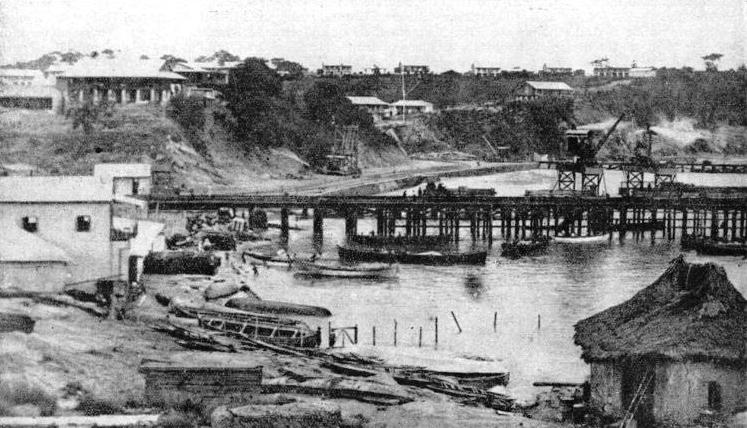
ON THE GULF OF GUINEA. Sekondi, a native seaside village, was chosen as the starting-
FEW railways in the world have played an important a part in the progress of twentieth century civilization as the Gold Coast Government Railway. A combination of engineering skill, railway organization, and wise administration by enlightened officials has made the railway a steel channel through forest and jungle, with the result that more progress has been achieved in two decades than was ever thought possible.
The railway is comparatively new, and every year it is being steadily improved. The engineers have to contend with the invisible germs of tropical diseases as well as with the visible difficulties of flood and jungle. Although this section of tropical Africa is no longer spoken of as “The White Man’s Grave”, and is being steadily improved, it still takes its toll of life.
The term “Gold Coast” covers three areas -
The total railway mileage is about 500 and the gauge is 3 ft 6-
The surprising thing is that whereas in the beginning of the century the natives were, comparatively speaking in the Stone Age, they now form a large proportion of the operating staff of the railway. The sons of men who, a few years ago, were fighting the British forces in one of Britain’s “little wars”, are now locomotive drivers or firemen, fitters, crane-
It is interesting to read the Administration Report on engine failures and to note the careful way in which details are handled. An engine had hot big ends and a fitter was cautioned for bad work; when a boiler leaked the driver was fined ten shillings for not plugging the tube; an engine was short of steam, and the driver had to pay a ten-
The discovery of gold at Tarkwa, some forty miles from the coast, led to the construction of the first section of railway from Sekondi, which was then a cluster of mud huts along the shore. In August, 1898, the engineers began to cut their way through the forest. In spite of a scarcity of labour, a trying climate, and the Ashanti War, the forty miles to Tarkwa were completed in May, 1901. The pacification of the country enabled construction to go forward more rapidly on the northern extension, Obuasi being reached in seventeen months, while the last section of forty-
In the ‘nineties prospectors hunting for gold penetrated the forest belt and panned the up-
Because of the lack of harbours, vessels had to anchor off the coast and discharge cargo into boats which ran the gauntlet of the heavy surf and dodged the sand-
The Superhuman Task
The boats took the material up the river to a point as near the mines as possible and unloaded. The material was then carried over the tracks through the jungle to the mines, but by the time the material reached its destination it had cost £40 a ton to transport. This cost rendered the working of the mines unprofitable, and it was decided to build a railway.
The first step was to scour the unprepossessing coast to find the site for the terminal port, and the native village of Sekondi was selected. It was not a harbour, only a small, open bay, and not until the harbour of Takoradi was constructed a few years ago were the difficulties of landing and loading surmounted. The construction of makeshift harbour works at Sekondi was restricted by the difficulties of the site and by the limited financial resources of the Colony; but at last they were completed, and the engineers then turned to the construction of the forty miles of railway to Tarkwa.
Although the distance was short, the dense jungle, the deadly climate, the heavy rainfall, and the comparative absence of suitable material with which to carry out the construction of the earthworks combined to make the length of forty miles a tremendous obstacle.
The surveyors had a superhuman task. The forest was so dense and overgrown with brushwood that it was seldom that a clear view of a hundred feet ahead could be obtained. The surveyor-
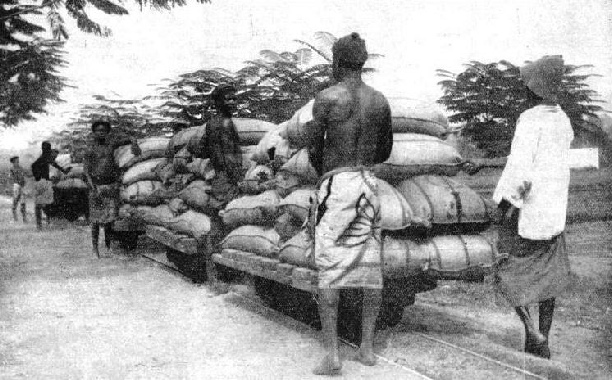
TRANSPORTING COCOA from the factory at Akuse to barges on the Volta River. Cocoa, first planted in the Colony in 1879, has become one of the most important products of the Gold Coast.
In such a country a surveyor needs to be gifted with a cast-
Owing to the amazing fertility of the soil the surveyor had to contend with a difficulty that is not found in temperate regions. In tropical countries the route decided upon is indicated by a row of pegs, spaced a hundred feet apart, down the middle of the survey cleavage through the scrub, the pegs indicating the centre of the track. At intervals they are supplemented on one side or the other by another stake, known as a “bench mark”, on which is marked the altitude.
When the surveyor set out the pegs in the Gold Coast jungle, the stakes, being cut from green wood, began to sprout as soon as he had moved on. Thus, within a very short time, the jungle growth closed over the survey line, obliterating it. Consequently the construction parties had to spend a long time searching for the location pegs. As soon as it was realized that a stick planted by the surveyor might grow into a small tree by the time the railway builder arrived, other methods were adopted. Whenever a bench or location mark of importance had to be indicated, the surveyor used something which could not grow. This was usually a small block of concrete, but these had to be used very sparingly, as each one had to be carried through the jungle on the head of a native.
When the track was being constructed an unusually wide space had to be cleared on either side, to protect the track and the telegraph wires from the effects of windfalls. Some of the trees grew to a height of 140 ft and more, and were easily brought down by a high wind, often falling across the track. Because of the dampness of the climate some of the trees were soft and hollow and brittle, but others were solid. A tough tree in the middle of the track would take two or three days to clear away. Natives, with their primitive tools, were nearly always employed on such tasks, as it was found that their methods were cheaper than employing white men with more costly appliances. These large trees averaged about twenty to the acre, and about forty acres per mile had to be cleared of all vegetation, so that this task in itself was a big one.
Even then the felling of the trees and the cutting of the undergrowth was only part of the work; for the vegetation, being useless for constructional purposes, had to be destroyed. The large trees were split, chopped into pieces, piled and fired, but as the wood was green the work took time.
Then the stumps had to be removed. As there was a thick upper layer of decaying vegetable matter the roots did not go deeply into the soil, but radiated in all directions along the surface. The method usually employed was to dig round the stump, sever the roots, and then haul the mass to one side by the aid of rope and tackle, to be burned later. Though this took time, it was preferable to blasting the stumps, as native labour could be used, whereas blasting would have required the services of skilled white men.
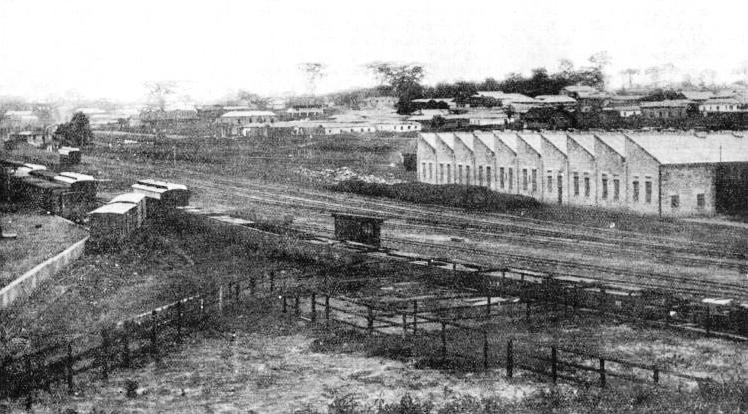
THE CAPITAL OF ASHANTI. A general view of Kumasi, the northernmost point of the railway, showing the railway sidings. Kumasi, former home of the Golden Stool, an object of local veneration, was linked by rail to Sekondi in 1903, after the Ashanti War.
Despite the width of the swathe through the forest, falling trees often obstructed the railway in its early years, the number of interruptions being as high as 200 in a year. About twice a year it was necessary to send out gangs to cut back the undergrowth, which, if left unchecked, would have overwhelmed the track.
Although gradients as steep as 1 in 50 and curves of 330 ft radius were introduced, it was not possible to avoid heavy earthworks in places. Rails weighing 50 lb per yard were laid upon pressed steel sleepers, since wooden sleepers would have been liable to attack and destruction by insects -
A feature of the construction was the lack of steam shovels and other “heavy artillery” of railway building. Because of the nature of the climate and the country it was found quicker, cheaper, and better to use the native and his methods. Nor was the spoil removed from one cutting used to build up the next embankment, as is the rule elsewhere. The spoil was thrown to one side, and the material required to fill a depression was taken from an adjacent borrow pit. Because there were no other means of transport, every ounce of transport had to be brought from the railhead by native carriers. There were no horses, mules, or oxen in the primeval jungle.
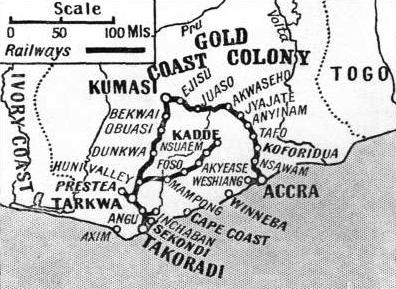
THE RAILWAY SYSTEM of the Gold Coast. Accra, the seat of government, was not connected by rail with Kumasi before 1923. The total route mileage is about 500, mainly on the 3 ft. 6 in. gauge.
The disadvantage of building the railway from one end only was that as soon as an embankment was raised the rails had to be laid over it, no interval being permitted to allow settlement to take place. As the earthworks were built on treacherous ground, and the ballast was little better than loam or silt, subsidence’s, were frequent, although the depressions were drained as far as practicable. When the wet season set in the new earthworks suffered heavily in places; the soft soil was washed away, it packed tightly, or else it spread, thereby producing ominous “sink holes”. Further dumping and ballasting had to be carried out, the metals being lifted with jacks as the ballast was tamped beneath.
As the line approached the gold district, the mines, instead of shipping their material over the route followed before the coming of the railway, landed it at Sekondi and sent it to the railhead, whence it was transported overland. The result was that the railhead became congested with railway constructional material for the line and with goods for the mines.
The labour question became acute as the line penetrated into the forest, which was uninhabited. Because of the suscep-
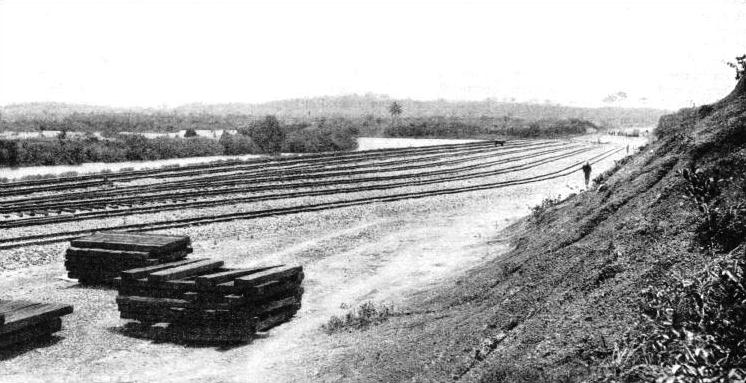
MARSHALLING SIDINGS on the branch railway from Sekondi to Takoradi. When the site of Takoradi Harbour was approved, it became necessary to link up the harbour railway with the main line from Sekondi into the interior.
They proved to be very intelligent, and most of them developed into good workmen. The camps, with rows of thatched huts, were so large that they resembled prosperous native villages. Men were picked out and were drilled in squads to act as police, to keep order among their fellows The pay day, once a month, was a great occasion All the natives, gaily bedecked as though for a fête, paraded at the engineer’s hut. They passed in a well-
The cost of construction was high, because of the distance from the source of supplies. Provisions, building material, and other supplies had to be brought from England, and the cost of transport was heavy. Certain articles, such as matches, sugar, and soap, which the Europeans had to have, cost several times their price in England by the time they were landed at Sekondi.
Every month a supply ship steamed out from Liverpool. The commissariat was a heavy responsibility with such a large army of workers; but it was organized so efficiently that it never failed, although there were anxious periods, such as that which followed the total wreck of a supply ship. When vessels arrived off Sekondi, much material was inevitably lost in tran-
As the railway was nearing Tarkwa in 1900 the Ashantis rose in revolt. In 1896 a British military expedition had been sent to Kumasi, the capital of Ashanti, and had arrested and deported King Prempeh and the Queen Mother. The Golden Stool of Ashanti was hidden by the Ashantis, and searches made by the British were unsuccessful. The people were very restive, and in March, 1900, when the Governor visited Kumasi, he told the assembled chiefs that they must surrender the Golden Stool. He also sent an officer to search for it. In less than a week the Ashantis rose in arms, and besieged the Governor and the garrison of Kumasi. The Governor, escorted by part of the garrison, reached the coast. The officer holding Kumasi was relieved in July, and the rebellion was put down.
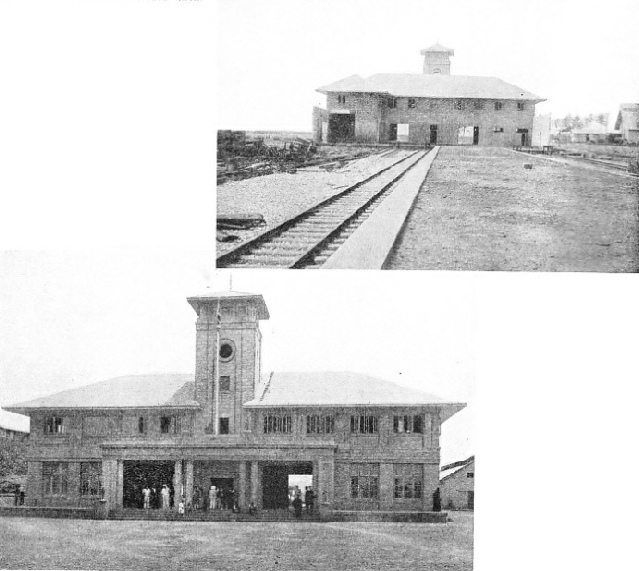
TAKORADI RAILWAY STATION. The harbour at Takoradi was opened on April 3, 1928, by Mr. J. H. Thomas, a former Secretary of State for the Colonies. The harbour branch railway from Sekondi, four miles north-
EXTERIOR VIEW of Takoradi Railway Station. The track mileage of the harbour railways is twenty-
But for more than twenty years the Ashantis hid their Golden Stool. In 1921, when a new road was being made, the guardians of the Stool feared it would be found, so they removed it from its hiding-
“The Golden Stool is very great. It contains the soul of the nation. We honour it so much that if it had been tampered with by anyone from outside we would have risen in arms, and it would not have mattered to us if we all perished the same day. We tender our thanks.”
The ill-
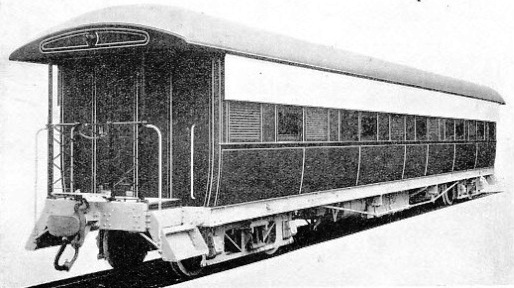
A FIRST-
Meanwhile a very remarkable man, Frederic Shelford, was hacking his way through the forest towards Kumasi, ignorant of the fact that a war was raging. Frederic Shelford was the son of Sir William Shelford, the engineer who initiated the railway conquest of West Africa by sending a, survey party to Sierra Leone in 1893, and also made the preliminary survey between Sekondi and Tarkwa. A year before the outbreak of the trouble over the Golden Stool, Mr. Shelford, who had taken over the reins of railway building operations on the retirement of his father, matured plans for continuing northwards from Tarkwa to Kumasi. Prospectors working north of the existing mines had discovered further deposits of gold. Mr. Shelford, who had been there, recognized the importance of this discovery and also the possibility of developing other resources which were lying dormant. He communicated with Mr. Joseph Chamberlain, who was then Colonial Secretary. Mr. Chamberlain replied to the effect that the Governor of the Gold Coast had suggested the building of a line from Accra, the British capital, to Kumasi. Mr. Chamberlain agreed that a railway should be built to the Ashanti stronghold, but suggested that surveys should be made both from Tarkwa and from Accra to Kumasi. He promised that the railway should be built with all possible speed when a favourable route was decided on.
Mr. Shelford set out with one assistant and fifty native porters to make the survey from Tarkwa to Kumasi. He soon found that, bad as conditions were between the coast and Tarkwa, conditions beyond Tarkwa were worse. It was a struggle through evil swamps and dense jungle, with such a terrific rainfall that it was not exceptional to experience four or five inches of rain in one tropical downpour.
There was not one native track to follow through the jungle, and the path had to be hacked, foot by foot, with a compass as the only guide. Mr. Shelford and his assistant were travelling light, to ensure that progress should not be impeded by heavy baggage. This means that the party had to cut necessities down to the bone. No camp outfit was carried except a few utensils for the preparation of food, and to filter and boil the drinking water. At the end of each day a clearing, a few yards in circumference, was made in the jungle to allow the camp, such as it was, to be pitched. The men slept on the rotting vegetation which covered the ground.
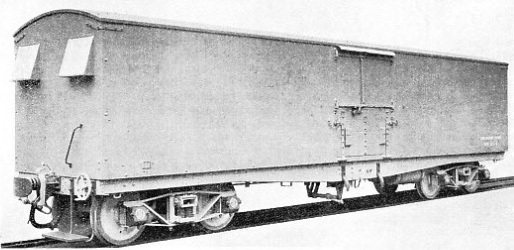
COVERED GOODS WAGON, built in Britain, for the Gold Coast Government Railways. The wagon runs on two four-
Before they had gone far Mr. Shelford’s assistant was struck down by blackwater fever. Then, although Mr. Shelford did not know it, the trouble over the Golden Stool flared up. He hacked his way steadily forward through the forbidding country, and, fortunately, did not encounter any natives. When he reached Kumasi he was surprised to find the English troops there, and was the first Englishman to enter the stronghold from Sekondi. The northward journey from Tarkwa had taken about three weeks. The survey made by Mr. Shelford was later compared with that made between Accra and Kumasi, and was accepted in preference, although, in later years, Accra too was linked with Kumasi.
When Kumasi was relieved, work on the section of the line from Sekondi to Tarkwa was resumed. It was completed in May, 1901. The development of the mines went ahead rapidly. The cost of transport fell from £40 to £5 a ton. The heaviest machinery was brought up to the mines and installed, and before long the mines were in full swing. There was no pause in railway construction. Steadily the line pushed forward into the difficult country, and in 1903 Kumasi was linked with Sekondi, a distance of 168 miles, the first train reaching the capital of Ashanti on October 1. It was not until twenty years later that, in 1923, the complete route Sekondi-
Profitable War-
In 1915 an important discovery was made which had an important effect on the progress of the railway. A great deposit of manganese was discovered at a spot near Akyem, a station on the Sekondi-
Cocoa was first planted in the Gold Coast Colony in 1879. Since then there has been a progressive increase in the areas cultivated and in the produce exported. During the five years ending 1926 the average yearly shipment exceeded 200,000 tons. Other crops include palm-
Soon after the war it was obvious that the Colony would need to have better harbour accommodation than that of the exposed jetties at Accra and Sekondi, and it was decided to build a deep-
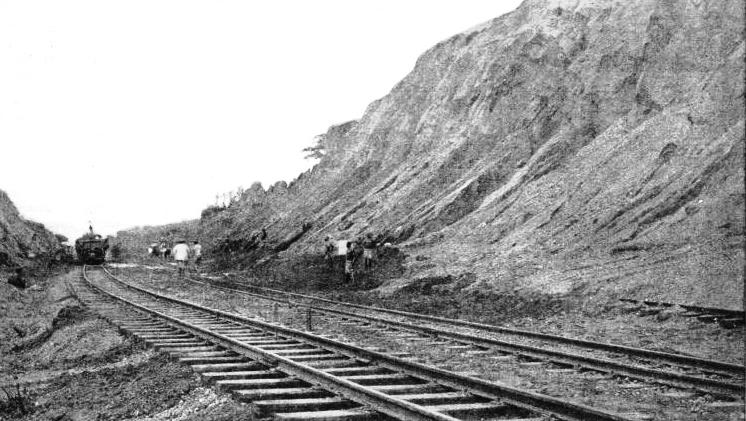
A CUTTING ON THE RAILWAY, showing a landslip due to the heavy rains. One of the tracks -
The “heavy artillery” of harbour construction was employed, as well as the ancient form of handling by head load; the result was ultimate success. The two main breakwaters enclose a water area of some 220 acres. The main breakwater is nearly a mile and a half in length, and is composed of granite rubble; it is topped by a concrete road, with a parapet wall of concrete on the seaward side. The core of the structure is protected by large random blocks of granite weighing from five to twelve tons. The finished top overall width is 30 feet.
The lee breakwater is smaller, the length being just under a mile, and the width at the top being 15 ft. Nearly two million tons of granite -
The harbour branch railway has become the beginning of the Takoradi-
The granite quarry is two miles from Sekondi and six and a half miles from the harbour. The granite lay under overburden which reached the depth of 50 ft in places. To ensure an uninterrupted output of rock it was found necessary to spoil the whole of this overburden to the rear of the quarry.
Fifteen-
A cutting 70 ft deep was made through the hill, and the adjoining ravine was spanned by a timber trestle bridge about 50 ft high. The cutting and the overburden were removed by head loads into Decauville wagons drawn by petrol locomotives. This method was necessary because of the presence of large boulders, and of the uneven surface of the granite; these conditions precluded the use of mechanical diggers.
The level of the quarry floor was determined by the requirements of gravitation drainage and by the existence of the Gold Coast Railway, which, running at right angles to the line from the quarry, had to be crossed by a diamond crossing. Five holes were sunk through the rock to the level decided upon, and were broken into one another to form a narrow gullet. This was then progressively widened out until the floor area was large enough to allow the use of five 15-
The rock was extracted by boring and blasting. The boring was done by thirty-
The average holes bored by the tripod drills were 24 ft deep, the jack hammers being used for holes of 6 ft and under. The drills were kept in condition by three pneumatically operated sharpening machines, with three oil-
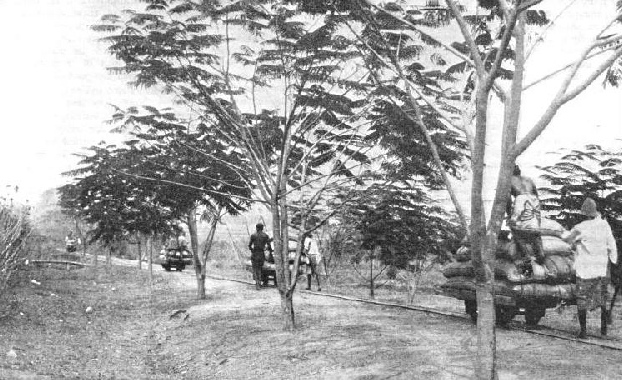
LIGHT RAILWAY used for conveying cocoa to the river barges. During the five years ended 1926 the average yearly shipment of cocoa exceeded 200,000 tons.
The explosive generally used was 42 per cent gelignite, although higher percentage gelignite and black powder were employed at times. Blasting was carried out twice a day, before the general start in the morning and during the midday meal hour. About 160 tons of explosives were used in the quarry, and the safety precautions were so efficient that there were no fatal accidents due to blasting. Damage to the plant was kept down by removing the travelling cranes from the face and by protecting the derricks with screens of stout round logs. threaded on wire bonds to form a mattress. After fifteen months a night shift was introduced into the working of the quarry.
There were two batteries of rock crushers near the main air-
The heaviest section of the main breakwater is 60 ft high, with a base 250 ft wide. The granite rubble was placed in this breakwater by a 15-
The rock was brought from the quarry to the breakwater in the large steel boxes, each containing about five cubic yards of rock, on flat bogie cars, two boxes on each car, in train loads of 500 tons at a time, drawn by two tender locomotives. The rock trains were marshalled in sidings at the approach to the breakwater; from this point they were drawn on to the breakwater by a side-
A Million Cubic Yards
In the construction of the smaller breakwater, rock was deposited by means of a 15-
The main wharf carries railways as well as crane tracks. It is 1,500 ft long, and has a deck 42 ft wide, carried by heavy reinforced concrete beams on cylindrical columns of 6 ft diameter. There are 246 of these columns, the shells of which were pre-
The divers excavating the sandstone for the foundations had to use jack hammers, high explosives, sand pumps, and water jets. Air compressors were placed on staging carried on the tops of unfinished cylinders. The water jets and sand pump were operated from barges.
The areas reclaimed necessitated the removal of more than a million cubic yards of material, chiefly from the great gash known as the Takoradi cutting. Much of this material was a very hard dark-
The harbour boundary is enclosed by an unclimbable iron fence, 7 ft high and 1,500 yards long. There are eleven gates.
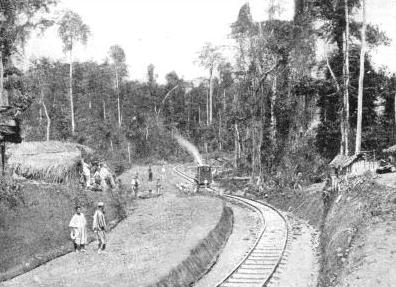
IN THE HEART OF THE JUNGLE. A view of Jim Abufu Station. Some of the forest trees attain a height of 140 ft, and are sometimes brought down by a high wind, often falling across the track.
The contractors paid such attention to the health of the workers that in the three years from September, 1924, to September, 1927, there were only three deaths from disease out of a total of 164 Europeans. There were seven cases of malaria, two Europeans died as the result of accidents, and seven were sent home owing to illness or because they were not suited to the climate. The average number of Africans employed during this period was 4,000 a day.
The men were housed in cool, substantial huts, built of “swish” rendered in cement, and all the huts were mosquito proofed, and had water-
The catering was done by the contractors. This avoided the loss of time and energy which would have resulted if the men had been left to their own resources. It also enabled all cooking materials and utensils and food to be under one roof, so that everything could be supervised and inspected. It was thus possible to see that the utmost cleanliness was preserved in cooking and in serving meals. In addition the employees had the advantage of a cold storage plant in which all food arriving from England was placed. Thus there was no illness due to food. There were hospitals, dressing stations, a cinema, a library, and a sports club.
It was intended at first that the Europeans should work for a period of eighteen months, but early in the course of the work a period of nine months was substituted, the average being, in practice, eight and a half months. This proved satisfactory, and the wisdom of it is reflected in the remarkable health figures quoted above, especially when compared with the heavy mortality among the railway pioneers at the beginning of the century.
A Royal Visit
The progress of the work was at first slow, and in 1925 the contract date for completion was extended to December, 1930. but a bonus was offered for earlier completion. By intensive working the contractors increased their rate of progress, and the harbour was opened on April 3, 1928, by the former Colonial Secretary, Mr. J. H. Thomas.
During the construction of the harbour the Prince of Wales, who visited the Colony in 1925, inspected the works at Takoradi. He arrived in HMS Repulse on April 9, and landed at a temporary stage at the breakwater. Only a few days before the surf had carried away part of the breakwater, and there was some anxiety on shore as the white surf-
The Prince’s visit included a journey by train from Sekondi to Kumasi, and a royal train was made up of fifteen coaches drawn by two locomotives, one of which bore in cast steel letters the name “Prince of Wales”. The coaches had been repainted throughout, and the interiors converted so that some were available as dining-
Preceded by a pilot train, the royal train left Sekondi station at six pm, soon traversed the hilly scrub country which borders the sea, and just before night fell the Prince obtained his first view of the gigantic forests. Soon after seven a halt was made for dinner, the Prince and his staff dining with the Governor in the Governor’s dining coach.
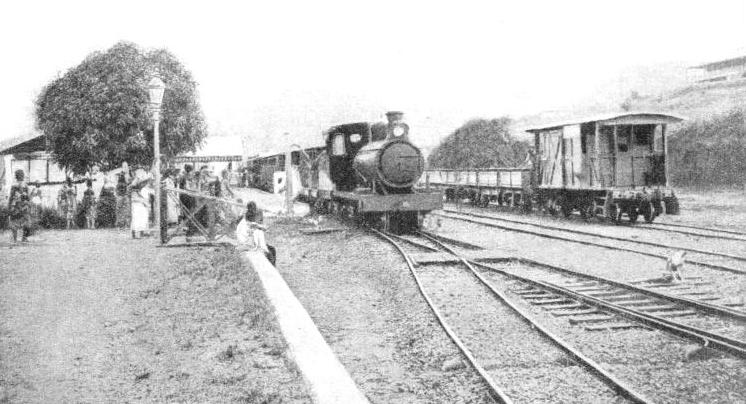
OBUASI RAILWAY STATION, north of Tarkwa. The Tarkwa-
Just before nine o’clock the train passed through the works of the great manganese mine at Nsuta, flares and other lights showing up dimly in the darkness the crowds of natives who work in the mines. A few minutes later the train arrived at Tarkwa station, where practically the entire population of the centre of the mining area of the Gold Coast had gathered. The Prince inspected native ex-
The spectacle was one that had never been seen before in the Ashanti jungle -
At half-
At this point the Prince left the train and travelled by road through the cocoa fields to Accra.
Modern Improvements
In recent years improvements to the track have been made. In 1928, because of track consolidation, the times of passenger trains between Sekondi and Kumasi were reduced by two hours forty minutes, and between Accra and Kumasi by forty-
Many of the bridges have been built by contractors; they include the Pra River bridge, which is 480 ft long, and the Offin River bridge, which has three 100-
Types of locomotives include the following: 4-
0-
4-
The first-
The locomotives and rolling-
The development of roads and motor transport has brought increased competition, especially from the African or Syrian setting up in business, who obtains the vehicle on the hire-
The cost of transport per ton-
As we have seen, the object of the first railway was to enable the gold mines to be operated by machinery. Not only was this object attained, but the railways were also able to help in developing the new industries which had not been foreseen by the early railway pioneers who toiled so arduously in the great forest.
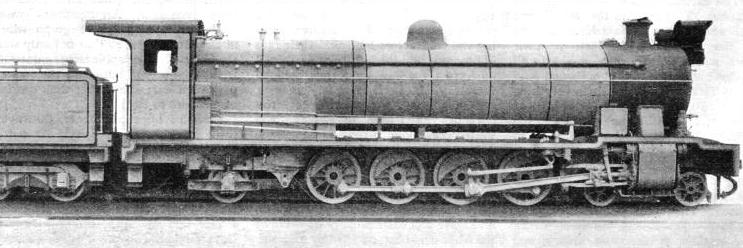
HEAVY 4-
You can read more on “Across Africa by Rail”, “Nigeria & Sierra Leone” and
“The Sekondi-